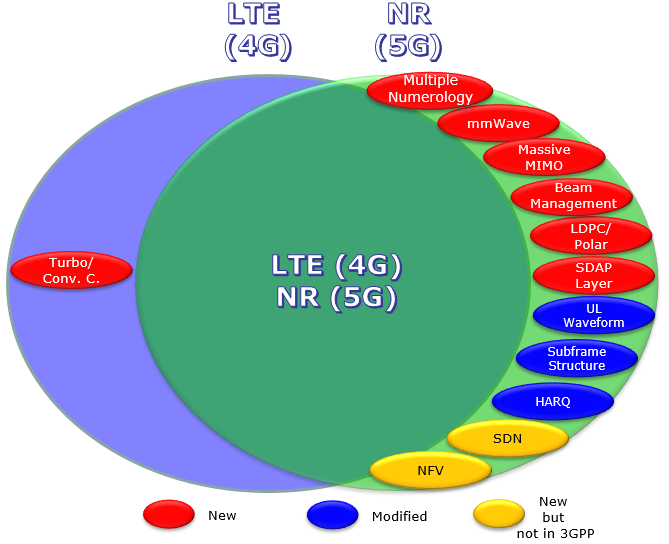|
|
||
|
When I started writing the pages about 5G in around mid 2013, I thought we will have a completely new (at least in Radio Access Protocol perspectivie) and I said to myself "After spending a couple of years in LTE and with a lot of struggle, finally just started to get used to this technology. Do I need to go through this kind of struggling again ?". At the early discussion, most of the discussions were around new physical waveform, implying that 5G is likely to be completely new technology from the bottom.
Fortunately to me (and probably to many people), with most of the initial implementation target determined in 3GPP as of TR 38.801, 38.802, 38.803, 38.804, it seems to me that most part (at least most part of Radio Access Procotol) overlaps with the current LTE and only small portions of new items are to be implemented anew as illustrated below (Of course this would sound over-simplified. You may say 'each of these new items are so fundamental, it should be regarded as pretty new technology'. I agree with this to some degree. It would be a huge changes in terms of low PHY. However, if you move forware only a half step upward and getting into high PHY(e.g,physical layer processing) and higher layer protocol, a lot of things would sound very similar (or almost same) to current LTE.
As of Jun 2017, 3GPP started releasing the formal technical specification. You would be able to get some more details of the big picture from 38.300 and for more detailed specification for each layers of protocol stack you may refer to 38.211(low PHY), 38.321(MAC), 38.322 (RLC), 38.323 (PDCP), 38.331(RRC) etc.
I would suggest you to keep this diagram in your mind and dig further into the details for each items. If you have a certain level of knowledge on LTE, learning NR from these differences will be more helpful rather than just looking into NR specification only. Here I would write down short descriptions as a starting point of your study. Take this just as an entry point and follow through the links under each of the items for further details.
Multiple Numerology
Simply put, Numerology means 'Subcarrier Spacing'. In LTE, there is only one numberology (subcarrier spacing) which is 15 Khz, but in NR various different types of subcarrier spacing are supported.
mmWave
Even though we will see NR deployment in Sub 6 Ghz (FR1) at early phase, the most unique aspect of NR deployment will be the support of mmWave (FR2).
Massive MIMO
In order to operate NR in mmWave, we need a special technology that can transmit the signal in a narrow beam. To do this, NR adopt a special technology called Massive MIMO. See Massive MIMO page for the details.
Beam Management
Beam Management is a set of process that can select, maintain and change beams between UE and gNB to maintain the stable connection. This process would be a critical part of NR operation in mmWave range. See Beam Management page for the details.
LDPC/Polar Coding
In LTE, Tail Bit Convolution Coding and Turbo Coding are the major technology for channel coding, but in NR Polar Coding and LDPC are adopted as major technology of channel coding. See Channel Coding page to see which channel uses which coding method.
SDAP Layer
SDAP is a completely new layer added to NR on top of PDCP. Main role of SDAP is to apply a sophisticated QoS for each of data stream.
Followings are not shown in the above diagram, but can be an important aspect worth noticing. These are mostly based on my personal experience and some of you may not agree with these.
Extremely complicated RRC
One of the best part of LTE that I found after struggling with WCDMA Release 99 for a long time was that RRC parameter in LTE has become so simple and clear. However, in NR I am afraid I start seeing the Rel 99-like complexity in NR RRC message. One of the reason for this complexity would be that NR is designed to be very flexible to support various use model (e.g, eMBB, eMTC, URLLC) and many parameters related to transport channel process is configured by RRC. Just as an example of this complexity, see NR RRC Reconfiguration page.
RRC / DCI Interplay
In LTE, the parameters in RRC and the parameters in DCI are pretty much independent except the csi request filed in Aperiodic CSI report process, but in NR DCI and RRC interplay become much more common practice as in the examples below.
BWP
In NR, there is a mechanism to define a portions of frequency region within a given band and let UE and gNB communicat within the portion. This fragment of band is called BWP(Bandwidth Part). At high level view, BWP would be a similar concept as Narrowband in LTE M1. But BWP can be defined in more flexible fashion than Narrowband. Refer to BWP page for the details.
Flexible UL/DL Configuration
Even though some of FDD mode operation is defined in Sub 6 Ghz (FR1) in NR, it is likely that the most of deployment would be done by TDD mode. Especially in mmWAVE, only TDD operation is defined. Refer to FR/Bandwidth page to see the band and frequency range and duplex mode. In TDD operation, we need to define which time slot should be used for DL(Downlink) and which time slot should be used for UL(Uplink). This kind of DL/UL transmission pattern is called DL/UL Configuration. In LTE TDD, there are only 7 different pattern are defined as shown here, but in NR the DL/UL pattern is configurable by RRC parameter in much more flexible way as shown in TDD DL/UL Common Configuration.
|
||
